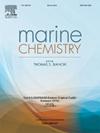Unsaturated aliphatic and sulfur-containing organic matter as surfactants in the surface microlayer
IF 2.5
3区 地球科学
Q2 CHEMISTRY, MULTIDISCIPLINARY
引用次数: 0
Abstract
The surface microlayer (SML) is a 10s–100s μm thick layer which mediates fluxes across the air-sea interface. Organic matter (OM) enrichments at the SML are known to influence SML physical properties and air-sea exchanges, but the role of detailed molecular level OM composition in influencing those processes hasn't been fully explored. SML and subsurface (SUB, 8–15 cm) water at four stations encompassing different influences (marine/fluvial/salt marsh) on the Delaware Bay system were sampled and examined for relationships between SML/SUB OM composition and surface tension. Samples collected December 2018–October 2019 show SML dissolved organic carbon (DOC) enrichments of 0.87 to 4.42 times the SUB concentration. Excitation-emission matrix spectroscopy (EEMs) and negative electrospray ionization (-ESI) Fourier-transform ion cyclotron resonance mass spectrometry (FT-ICR MS) show marine samples have higher contributions from photobleached material and higher relative abundances of CHON compounds relative to inner bay sites, respectively. Principal component analyses further reveal consistent differences in SML OM composition relative to SUB. The SML contains higher abundances of compounds with H/C > 1.7 and O/C < 0.2, including sulfur-containing compounds - compositions suggestive of surfactant-like molecules, able to depress surface tension at the air-sea interface. Surface tension depressions were significantly correlated with unsaturated aliphatic and sulfur-containing compounds identified from FT-ICR MS data, yet showed no relationship with DOC abundances or enrichments, highlighting the need for compositional assessments for understanding OM influences on SML properties and air-sea exchanges. The sources and structures of SML surfactant molecules should be a focus of future work.
不饱和脂肪族和含硫有机物作为表面活性剂在表面微层
表面微层(SML)是一层10 ~ 100 μm厚的介质层,通过海气界面调节通量。已知SML的有机质(OM)富集会影响SML的物理性质和海气交换,但详细的分子水平OM组成在影响这些过程中的作用尚未得到充分探讨。对特拉华湾系统不同影响(海洋/河流/盐沼)的四个站点的SML和地下(SUB, 8-15 cm)水进行了采样,并检查了SML/SUB OM组成与表面张力之间的关系。2018年12月至2019年10月采集的样品显示,SML溶解有机碳(DOC)浓度为SUB浓度的0.87至4.42倍。激发-发射矩阵光谱(EEMs)和负电喷雾电离(-ESI)傅里叶变换离子回旋共振质谱(FT-ICR MS)显示,海洋样品中光漂白物质的贡献更高,CHON化合物的相对丰度相对于内湾站点更高。主成分分析进一步揭示了SML OM组成相对于SUB的一致差异。SML含有较高的H/C和gt化合物丰度;1.7和O/C <;0.2,包括含硫化合物——表面活性剂类分子的组成,能够降低海气界面的表面张力。表面张力下降与FT-ICR MS数据中鉴定的不饱和脂肪族和含硫化合物显著相关,但与DOC丰度或富集度没有关系,这表明需要进行成分评估,以了解OM对SML性质和海气交换的影响。SML表面活性剂分子的来源和结构是今后研究的重点。
本文章由计算机程序翻译,如有差异,请以英文原文为准。
求助全文
约1分钟内获得全文
求助全文
来源期刊

Marine Chemistry
化学-海洋学
CiteScore
6.00
自引率
3.30%
发文量
70
审稿时长
4.5 months
期刊介绍:
Marine Chemistry is an international medium for the publication of original studies and occasional reviews in the field of chemistry in the marine environment, with emphasis on the dynamic approach. The journal endeavours to cover all aspects, from chemical processes to theoretical and experimental work, and, by providing a central channel of communication, to speed the flow of information in this relatively new and rapidly expanding discipline.
 求助内容:
求助内容: 应助结果提醒方式:
应助结果提醒方式:


